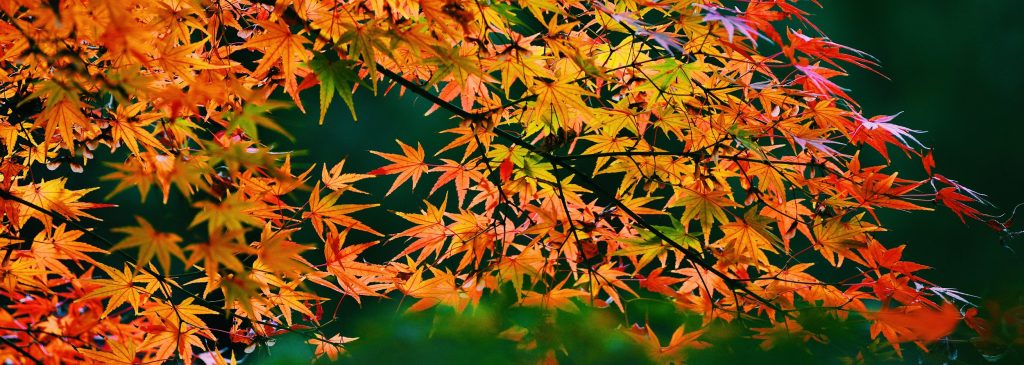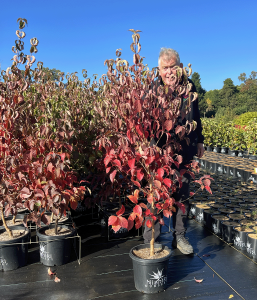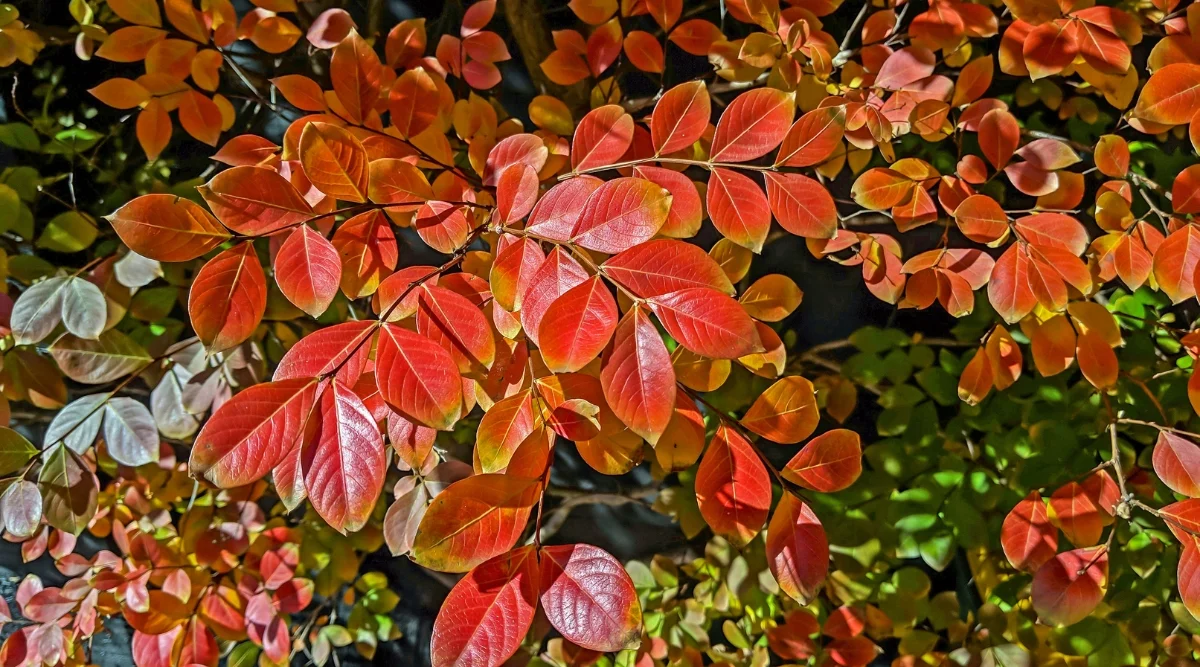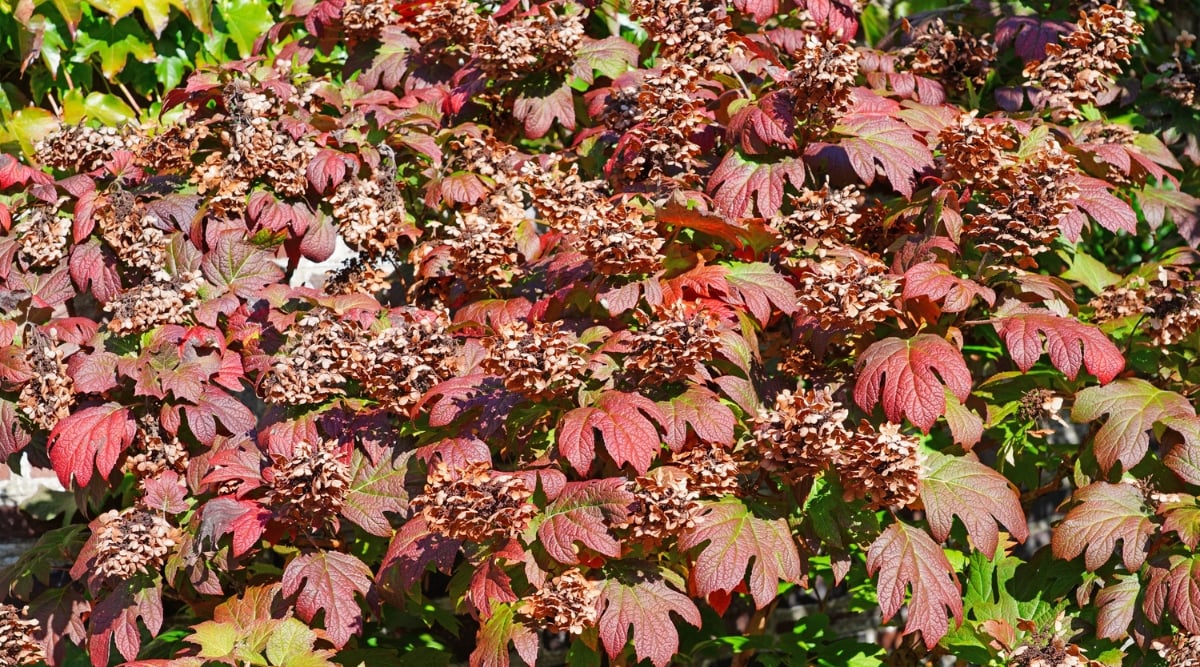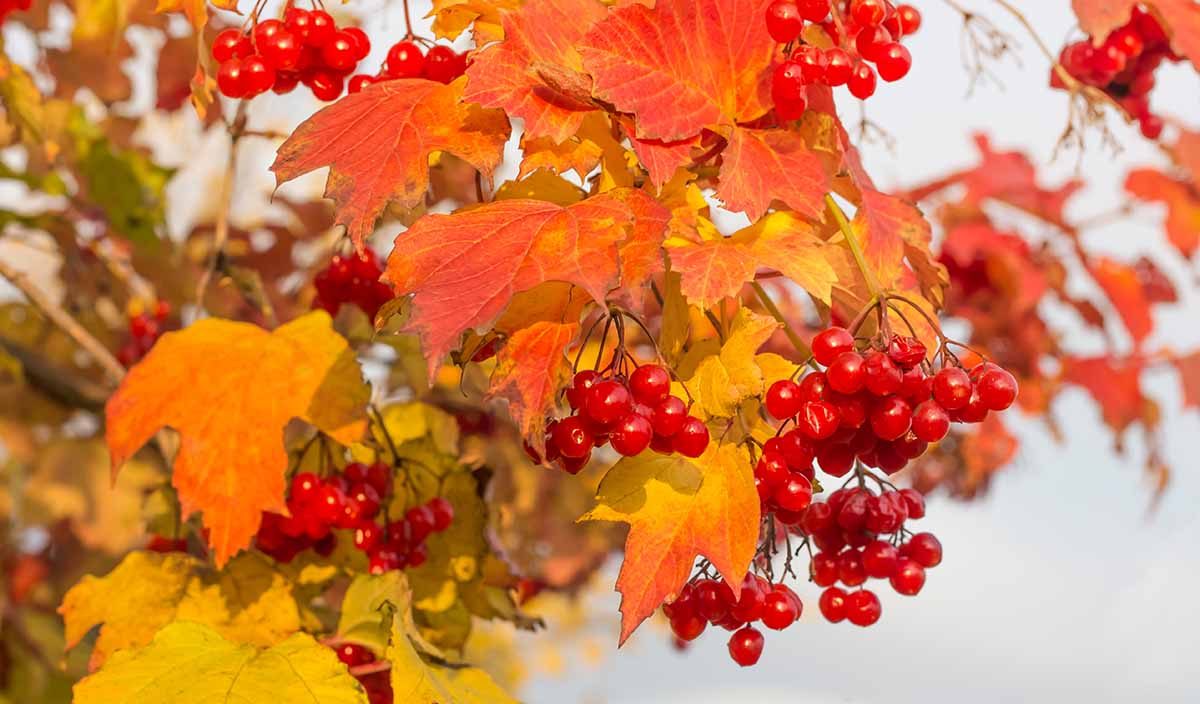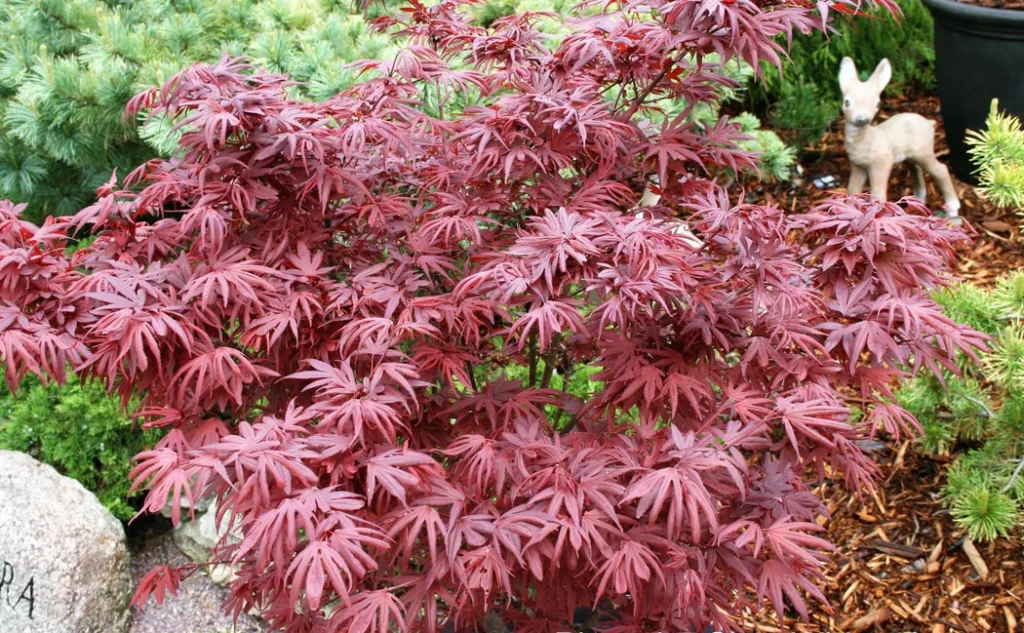13 of the Most Spectacular Autumn Plant Colours
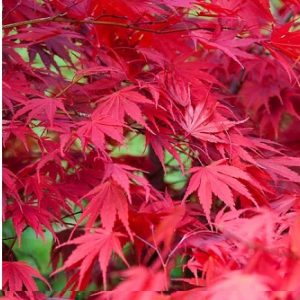 Also known as your Plain Japanese Maple, this is a great option for those who want a Japanese Maple, but don’t want to spend too much money on it. But this doesn’t mean it’s lacking when it comes to beauty. The fine foliage transforms into a striking red-pink shade that would stop anyone in their tracks to admire. When I was a kid, I actually used to cut big bunches of it and sell them on the side of the road, and people pulled up and bought it like crazy. I don’t know if that would still happen nowadays… but anyways, the great thing about your Japanese Maple is they’ve probably got one of the safest root systems of any plant.
Also known as your Plain Japanese Maple, this is a great option for those who want a Japanese Maple, but don’t want to spend too much money on it. But this doesn’t mean it’s lacking when it comes to beauty. The fine foliage transforms into a striking red-pink shade that would stop anyone in their tracks to admire. When I was a kid, I actually used to cut big bunches of it and sell them on the side of the road, and people pulled up and bought it like crazy. I don’t know if that would still happen nowadays… but anyways, the great thing about your Japanese Maple is they’ve probably got one of the safest root systems of any plant.
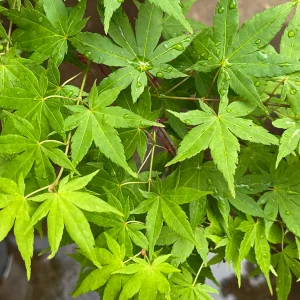 So you can plant them close to the house or in a little courtyard and having nothing to worry about. They’re very versatile – you can cloud prune them, or you can bonsai them. They’re also a tree you can keep in a pot for years, as long as you properly take care of it. Water and fertilise it enough, with some Osmocote or Dolomite Lime, or it’s going to turn brown by the end of the season. A little tip, if you’re getting early autumn colour then this is actually not a good thing. It’s a sign of stress, dryness and perhaps a lack of nutrients. So just make sure you’re taking care of your Japanese Maple, and it will reward you with brilliant autumn colour.
So you can plant them close to the house or in a little courtyard and having nothing to worry about. They’re very versatile – you can cloud prune them, or you can bonsai them. They’re also a tree you can keep in a pot for years, as long as you properly take care of it. Water and fertilise it enough, with some Osmocote or Dolomite Lime, or it’s going to turn brown by the end of the season. A little tip, if you’re getting early autumn colour then this is actually not a good thing. It’s a sign of stress, dryness and perhaps a lack of nutrients. So just make sure you’re taking care of your Japanese Maple, and it will reward you with brilliant autumn colour.
Of course I’m going to include another Japanese Maple – they’re just too gorgeous in the autumn to not. In perfect conditions they only end up as a four-metre tree, and with a bit of a trim you can keep it down to two and half or three metres. I often tell people to Google Senkaki Maple, so go ahead and do it. A little bit confused? You’ve probably gotten a page of entirely different coloured foliage and you’re thinking whether it’s all the same tree, it is.
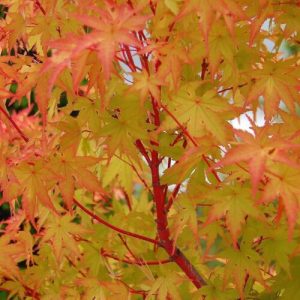 Basically Senkaki Maples move through a wide range of hues throughout the year. In winter they’re bare, with that crimson bark on display. In springtime, the softest green foliage comes through, where the crimson branches just peek through. Towards summer you start to get dashes of pink and orange tones that expand as summer goes on. Then by the end of summer and turn of autumn, you have an iridescent gold, with some touches of pink and orange. In the final stages of autumn you get red hues, before the leaves drop. Just magical. This is a tree that is going to provide delight and interest year-round. They also go with almost any style; modern, classical, Japanese, they always look incredible. So if you’ve got a tiny area with room for only one tree – then hands down you have to pick a Senkaki.
Basically Senkaki Maples move through a wide range of hues throughout the year. In winter they’re bare, with that crimson bark on display. In springtime, the softest green foliage comes through, where the crimson branches just peek through. Towards summer you start to get dashes of pink and orange tones that expand as summer goes on. Then by the end of summer and turn of autumn, you have an iridescent gold, with some touches of pink and orange. In the final stages of autumn you get red hues, before the leaves drop. Just magical. This is a tree that is going to provide delight and interest year-round. They also go with almost any style; modern, classical, Japanese, they always look incredible. So if you’ve got a tiny area with room for only one tree – then hands down you have to pick a Senkaki.
Smoke Bushes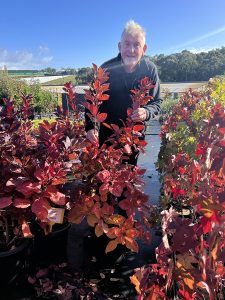 are fabulous plants with a beautiful reddish/purple foliage most of the time. Then in autumn it shifts to orange, red and yellow shades. They love a hot sunny spot and with a bit of a trim can be kept down to one and half metres tall, or grown up to around two and half/ three metres tall. I wouldn’t put them in a pot, rather plant them in the garden bed. They’re a lovely thick bush that also flowers in summer. The flowers are a smoky grey and contrast beautifully with the foliage. What’s great about the Smoke Bush and Senkaki is that they’re not boring all year with only a show of colour in autumn. They give your garden colour for nine months and then have an amazing crescendo of autumn colour too.
are fabulous plants with a beautiful reddish/purple foliage most of the time. Then in autumn it shifts to orange, red and yellow shades. They love a hot sunny spot and with a bit of a trim can be kept down to one and half metres tall, or grown up to around two and half/ three metres tall. I wouldn’t put them in a pot, rather plant them in the garden bed. They’re a lovely thick bush that also flowers in summer. The flowers are a smoky grey and contrast beautifully with the foliage. What’s great about the Smoke Bush and Senkaki is that they’re not boring all year with only a show of colour in autumn. They give your garden colour for nine months and then have an amazing crescendo of autumn colour too.
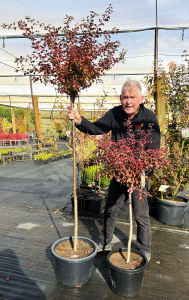
 Kojo No Mai has a curly kind of foliage with beautiful tiny pink-white blossoms during the springtime. It’s grafted up on a standard and you can buy it as a low standard or a tall standard. It’s quite a compact plant that you can grow in a pot, making sure to water and fertilise it well. But you can also grow it in the garden. It looks beautiful year-round, in the summer it has green pine foliage and blossoms, in winter is has interesting curly branches, then come autumn you get magnificent burgundy autumn colour.
Kojo No Mai has a curly kind of foliage with beautiful tiny pink-white blossoms during the springtime. It’s grafted up on a standard and you can buy it as a low standard or a tall standard. It’s quite a compact plant that you can grow in a pot, making sure to water and fertilise it well. But you can also grow it in the garden. It looks beautiful year-round, in the summer it has green pine foliage and blossoms, in winter is has interesting curly branches, then come autumn you get magnificent burgundy autumn colour.
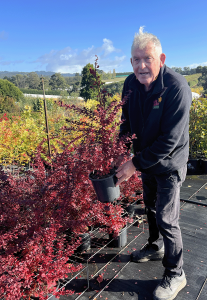 There are all different types of Berberis with different autumn colours, but today I’m going to talk about the Purple one. You can plant it as a hedge and trim it into a square, or you can trim it into a ball. The Purple Berberis is the most common and popular of the Berberis. As you come into autumn it will be this bright purple that shifts into shades of orange, yellow and red. With a trim you can keep it under a metre, or let it grow to its full height of about two metres.
There are all different types of Berberis with different autumn colours, but today I’m going to talk about the Purple one. You can plant it as a hedge and trim it into a square, or you can trim it into a ball. The Purple Berberis is the most common and popular of the Berberis. As you come into autumn it will be this bright purple that shifts into shades of orange, yellow and red. With a trim you can keep it under a metre, or let it grow to its full height of about two metres.
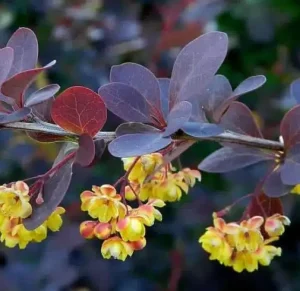 You can mass plant it for a beautiful splash of colour in your garden, or even plant different types of Berberis and have a wide array of shades. For example there is the Berberis ‘Little Favourite’ Barberry that has burgundy purple foliage which changes to a bright red and orange in autumn, with cream flowers during the springtime. I’ve never used them as a pot plant, but I don’t see why you couldn’t, as they’re a hearty and easy to grow plant.
You can mass plant it for a beautiful splash of colour in your garden, or even plant different types of Berberis and have a wide array of shades. For example there is the Berberis ‘Little Favourite’ Barberry that has burgundy purple foliage which changes to a bright red and orange in autumn, with cream flowers during the springtime. I’ve never used them as a pot plant, but I don’t see why you couldn’t, as they’re a hearty and easy to grow plant.
This is the Dogwood that most people know, with its beautiful white flowers and lovely red autumn colour. What’s great about White Dogwood is that it’s quite an exotic looking plant and its autumn colour is long-lasting. You don’t expect a plant that looks so incredible in the summer, with its riot of intricate flowers, to then give you such fabulous autumn colour. Your Dogwood is an understory tree, which means that it naturally grows in the forest underneath other trees. So if you have some great big trees or a two-story house towering over your place, then the White Dogwood will thrive in that shady spot. Just make sure you give it loose soil, bit of water and a bit of fertilizer.
 Similar to the Senkaki maple, if there was only room for one tree than the Crepe Myrtle is a great option. Your first thought of the Crepe Myrtle is likely the beautiful pink-white flowers, which is quite magnificent. But not long after the flowering is finished, you get the most vibrant autumn colours that lingers for weeks. Some autumn colours are beautiful but fleeting, here today and then gone a few days later. But with the Crepe Myrtle, the autumn colour goes on and on. The different varieties of Crepe Myrtle all have slightly different shades. The Sioux is one of my favourites for its beautiful soft pink flowers and smaller size. Some Crepe Myrtles will grow to four or five metres, but Sioux doesn’t get much bigger than three metres. With a bit of pruning you can easily keep it to one or two metres.
Similar to the Senkaki maple, if there was only room for one tree than the Crepe Myrtle is a great option. Your first thought of the Crepe Myrtle is likely the beautiful pink-white flowers, which is quite magnificent. But not long after the flowering is finished, you get the most vibrant autumn colours that lingers for weeks. Some autumn colours are beautiful but fleeting, here today and then gone a few days later. But with the Crepe Myrtle, the autumn colour goes on and on. The different varieties of Crepe Myrtle all have slightly different shades. The Sioux is one of my favourites for its beautiful soft pink flowers and smaller size. Some Crepe Myrtles will grow to four or five metres, but Sioux doesn’t get much bigger than three metres. With a bit of pruning you can easily keep it to one or two metres.
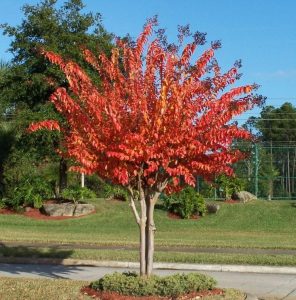 Another great feature is that once they’ve matured, they get this beautiful pattern on their bark. With some flowering trees they’re only pretty in the springtime and boring for the rest of the year, but the Crepe Myrtle provides excitement year-round. If you do have the space, Crepe Myrtles are fantastic mass planted up a driveway or avenue, but even if you just have room for one tree, it’s still going to look fantastic. With beautiful bark, exquisite flowers, and brilliant autumn colours, the Crepe Myrtle really earns its keep as an ornamental tree.
Another great feature is that once they’ve matured, they get this beautiful pattern on their bark. With some flowering trees they’re only pretty in the springtime and boring for the rest of the year, but the Crepe Myrtle provides excitement year-round. If you do have the space, Crepe Myrtles are fantastic mass planted up a driveway or avenue, but even if you just have room for one tree, it’s still going to look fantastic. With beautiful bark, exquisite flowers, and brilliant autumn colours, the Crepe Myrtle really earns its keep as an ornamental tree.
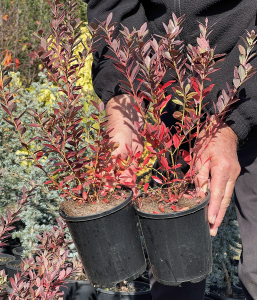 I never thought that the Blueberry Bush had good autumn colour until Carl, a great nurseryman, brought one of them. This was back when I had a nursery in Emerald, and he would grow a few plants for me. Carl brought in this beautiful bush, about half a metre tall and half a metre wide, and it had the most beautiful autumn colour. I asked him what it was, and he told me it was a Blueberry Bush. I was quite surprised. You can grow it in a pot, or a little corner of the garden, and it’s going to give you cute flowers then fantastic autumn colour. Not to mention you’re also getting blueberries!
I never thought that the Blueberry Bush had good autumn colour until Carl, a great nurseryman, brought one of them. This was back when I had a nursery in Emerald, and he would grow a few plants for me. Carl brought in this beautiful bush, about half a metre tall and half a metre wide, and it had the most beautiful autumn colour. I asked him what it was, and he told me it was a Blueberry Bush. I was quite surprised. You can grow it in a pot, or a little corner of the garden, and it’s going to give you cute flowers then fantastic autumn colour. Not to mention you’re also getting blueberries!
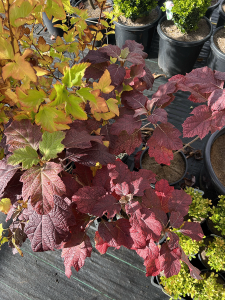 This is one of the most underrated plants for autumn colour. In spring and all throughout summer you have these fantastic flowers. But then with other types of hydrangeas, pretty much straight after Mother’s Day, the leaves would turn rotten and fall off. It would look like something from a horror movie. But your Oakleaf has intense autumn colour, a deep purple shade, and the leaves don’t drop off. They stay there until new bright leaves come in around middle of September, then you have this period of time where green leaves are appearing amongst purple leaves, creating a kaleidoscope of colour. Also compared to other hydrangeas it’s a bit lower and wider growing. They’re my favourite hydrangea because come winter, they don’t shapeshift into a creature from a horror film.
This is one of the most underrated plants for autumn colour. In spring and all throughout summer you have these fantastic flowers. But then with other types of hydrangeas, pretty much straight after Mother’s Day, the leaves would turn rotten and fall off. It would look like something from a horror movie. But your Oakleaf has intense autumn colour, a deep purple shade, and the leaves don’t drop off. They stay there until new bright leaves come in around middle of September, then you have this period of time where green leaves are appearing amongst purple leaves, creating a kaleidoscope of colour. Also compared to other hydrangeas it’s a bit lower and wider growing. They’re my favourite hydrangea because come winter, they don’t shapeshift into a creature from a horror film.
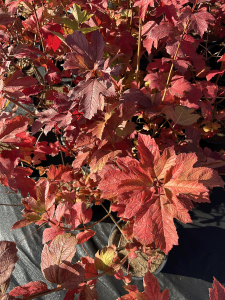 A few decades ago these were the most popular bush in Melbourne and it’s easy to see why. With those clusters of creamy white blossoms, they truly look like snowballs or even clouds, covering the bush. Back then I never noticed how nice their autumn colour is, but I found a patch of them in the nursery today and they look incredible. You’re probably noticing that a lot of the plants on this list aren’t just great for their autumn colour, but rather give you beauty in so many other ways too. It’s because you don’t plant a garden just for one season, you plant a garden to give you eternal wonder and delight. Surprisingly, the Snowball Bush isn’t as common nowadays, so perhaps a resurgence like the ornamental grass is due (stay tuned for an article on ornamental grasses coming soon). They’re super compact so perfect for a tight space. The foliage starts out as a bright green, then with autumn it changes to a gorgeous reddish orange. Even the flowers themselves do some colour-shifting, beginning as an apple-green, morphing to white, and eventually fading to a rosy colour.
A few decades ago these were the most popular bush in Melbourne and it’s easy to see why. With those clusters of creamy white blossoms, they truly look like snowballs or even clouds, covering the bush. Back then I never noticed how nice their autumn colour is, but I found a patch of them in the nursery today and they look incredible. You’re probably noticing that a lot of the plants on this list aren’t just great for their autumn colour, but rather give you beauty in so many other ways too. It’s because you don’t plant a garden just for one season, you plant a garden to give you eternal wonder and delight. Surprisingly, the Snowball Bush isn’t as common nowadays, so perhaps a resurgence like the ornamental grass is due (stay tuned for an article on ornamental grasses coming soon). They’re super compact so perfect for a tight space. The foliage starts out as a bright green, then with autumn it changes to a gorgeous reddish orange. Even the flowers themselves do some colour-shifting, beginning as an apple-green, morphing to white, and eventually fading to a rosy colour.
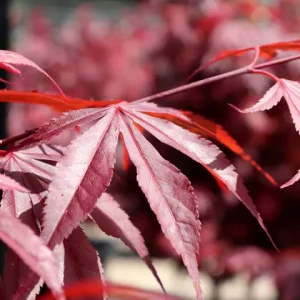 Look, we could do an entire list on Japanese Maples, but I’m trying to be very selective with which ones I put here, because not everyone wants a Japanese Maple. But the Shaina is really a standout because it’s a miniature Japanese Maple that is perfect for people tight on space. Shaina has very fine leaves and dense foliage which add to the intensity of its red colouring. It’s so small you can have it in a pot and keep it there forever. If you never trimmed it, Shaina would probably end up two metres tall in 10 or 15 years, but if you trimmed it a little bit you could easily keep it a metre tall.
Look, we could do an entire list on Japanese Maples, but I’m trying to be very selective with which ones I put here, because not everyone wants a Japanese Maple. But the Shaina is really a standout because it’s a miniature Japanese Maple that is perfect for people tight on space. Shaina has very fine leaves and dense foliage which add to the intensity of its red colouring. It’s so small you can have it in a pot and keep it there forever. If you never trimmed it, Shaina would probably end up two metres tall in 10 or 15 years, but if you trimmed it a little bit you could easily keep it a metre tall.
 The ‘Sugar’ Maple is one of my all-time favourite plants for autumn colour, so I wanted to include this too, however this is quite a large tree. In autumn it is a bright yellow with more subtle tones of orange, pink and red. It almost looks like it is glowing with soft flames. Because of this, it’s typically overlooked, but I love the subtlety.
The ‘Sugar’ Maple is one of my all-time favourite plants for autumn colour, so I wanted to include this too, however this is quite a large tree. In autumn it is a bright yellow with more subtle tones of orange, pink and red. It almost looks like it is glowing with soft flames. Because of this, it’s typically overlooked, but I love the subtlety.
The autumn colour of Boston Ivy is unbelievable, not to mention how beautiful and luscious it looks in the summer. Use the right soil, bit of water and fertiliser, and keep it trimmed for the best look. Boston Ivy is a climber so it can really elevate a wall, fence, or the side of the house. Then in autumn the dark green foliage will turn crimson, standing out dramatically against the rest of your landscape.
So there are some of the plants with the most brilliant autumn colour. Of course, this list isn’t exhaustive, but I wanted to make this for those who want autumn colour, but are completely overwhelmed by all the choices. You’ve probably noticed here in Melbourne that summer is well and truly gone, the days are getting colder, and the sun is setting sooner. Autumn is officially here. Which means there is no better time to come down to Hello Hello and see for yourself the incredible autumn colour on these plants.
May your autumn be filled with fiery hues,
Chris











